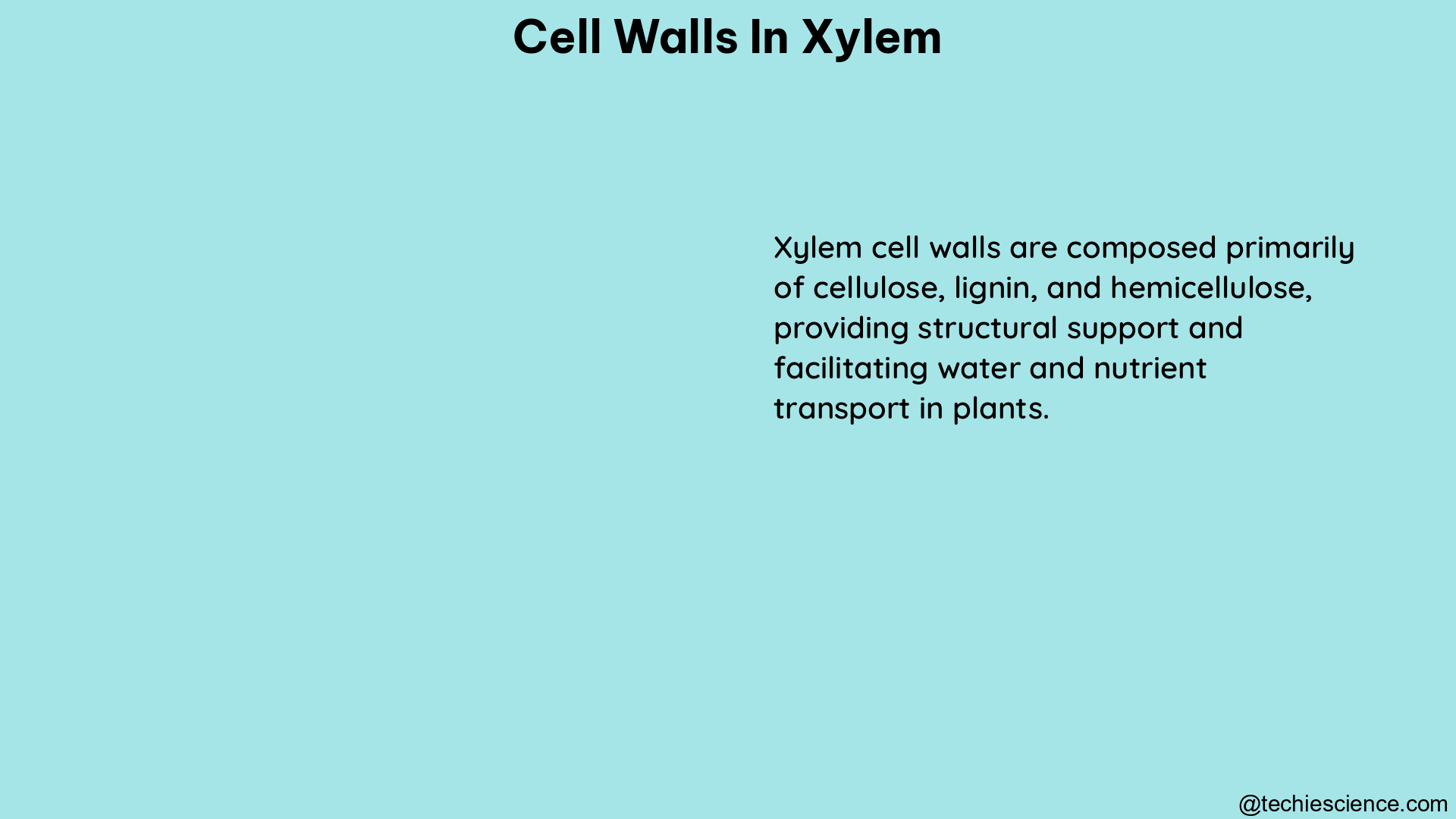The cell walls in xylem are crucial for the transportation of water and nutrients in plants. They possess unique patterns of secondary cell-wall thickening, such as spiral or pitted patterns, and are strengthened with lignin, which thickens and reinforces them, allowing them to withstand the pressure difference between atmospheric pressure and the pressure inside the xylem vessels.
Understanding the Structural Composition of Xylem Cell Walls
Xylem cell walls are composed of several layers, each with its own distinct characteristics:
-
Primary Cell Wall: The primary cell wall is the first layer formed during cell growth and development. It is thin, flexible, and composed of cellulose, hemicellulose, and pectin.
-
Secondary Cell Wall: The secondary cell wall is deposited on the inner surface of the primary cell wall after the cell has stopped growing. It is thicker and more rigid, and is composed of cellulose, hemicellulose, and lignin.
-
Tertiary Cell Wall: In some xylem cells, a third layer, known as the tertiary cell wall, may be deposited on the inner surface of the secondary cell wall. This layer is even thicker and more lignified, providing additional strength and support.
The specific patterns of secondary cell-wall thickening in xylem cells, such as spiral or pitted patterns, are crucial for their function in water and nutrient transport. These patterns create a network of interconnected channels and pores that facilitate the efficient movement of fluids through the plant.
Lignification: The Key to Xylem Cell Wall Strength

Lignin is a complex organic polymer that is deposited in the cell walls of xylem cells, providing them with exceptional strength and rigidity. The process of lignification involves the polymerization of three primary monolignol precursors: p-coumaryl alcohol, coniferyl alcohol, and sinapyl alcohol.
The deposition of lignin in the cell walls occurs in a specific pattern, with the highest concentration in the secondary cell wall and the lowest in the primary cell wall. This uneven distribution of lignin contributes to the overall structural integrity of the xylem cells.
The degree of lignification in xylem cell walls can vary depending on the plant species, the age of the plant, and the environmental conditions. In general, older xylem cells tend to be more heavily lignified, providing greater support and resistance to compression and tension forces.
Programmed Cell Death in Xylem: A Crucial Process
Programmed cell death (PCD) is a crucial process in the development and maintenance of xylem cells. A study using imaging flow cytometry has provided valuable insights into the different stages of PCD in xylem cells.
The study categorized xylem cells into three subgroups based on their morphology, staining, and size:
-
Healthy Cells: These cells had a round morphology, a cell size of 1-7 μm, and no staining, indicating good cell activity.
-
Early PCD: These cells had a slightly shrunken morphology, a cell size of 8-10 μm, and annexin V-FITC staining, indicating phosphatidylserine exposure and early PCD.
-
Late PCD: These cells had the largest cell size (about 15 μm), an irregular shape, condensed and fragmented nuclei, and both annexin V-FITC and PI staining, suggesting late PCD.
The study highlighted the importance of efficient and accurate methods, such as flow cytometry, to detect and analyze PCD in woody plants. Understanding the different stages of PCD in xylem cells can contribute to basic research in this field and help elucidate the mechanisms underlying xylem development and function.
The Role of Xylem Cell Walls in Transpiration
The adhesive property of water and evaporation generate tension forces in leaf cell walls, playing a crucial role in the transpiration-pull process. Transpiration is a passive process driven by the evaporation of water from the leaf, leading to a decrease in pressure and the creation of tension forces in the leaf cell walls.
These tension forces are then transmitted through the xylem vessels, creating a “transpiration-pull” that drives the movement of water and nutrients from the roots to the leaves. The strength and integrity of the xylem cell walls are essential for withstanding these tension forces and maintaining the efficient transport of water and nutrients throughout the plant.
Conclusion
The cell walls in xylem are a complex and vital component of plant anatomy, playing a crucial role in the transportation of water and nutrients. Understanding the structural composition, lignification, and programmed cell death processes in xylem cell walls is essential for advancing our knowledge of plant physiology and development. By exploring these intricate details, we can gain valuable insights that can contribute to the field of plant biology and potentially inform practical applications in agriculture and horticulture.
References:
- Xylem Cell – an overview | ScienceDirect Topics. (n.d.). Retrieved from https://www.sciencedirect.com/topics/medicine-and-dentistry/xylem-cell
- A method for analyzing programmed cell death in xylem … – NCBI. (n.d.). Retrieved from https://www.ncbi.nlm.nih.gov/pmc/articles/PMC10288846/
- Transport in the Xylem of Plants. (n.d.). Retrieved from https://www.mrgscience.com/topic-91-transport-in-the-xylem-of-plants.html
- Xylem Cell – an overview | ScienceDirect Topics. (n.d.). Retrieved from https://www.sciencedirect.com/topics/immunology-and-microbiology/xylem-cell
- Quantification of xylem embolism in the stem of a Curly birch sapling. (n.d.). Retrieved from https://www.researchgate.net/figure/Quantification-of-xylem-embolism-in-the-stem-of-a-Curly-birch-sapling-a-Sap-filled_fig1_236137926
Hey! I am Sneha Sah, I have completed post graduation in Biotechnology. Science has always been fascinating to me and writing is my passion. As an academic writer my aim is to make Science easy and simple to learn and read.